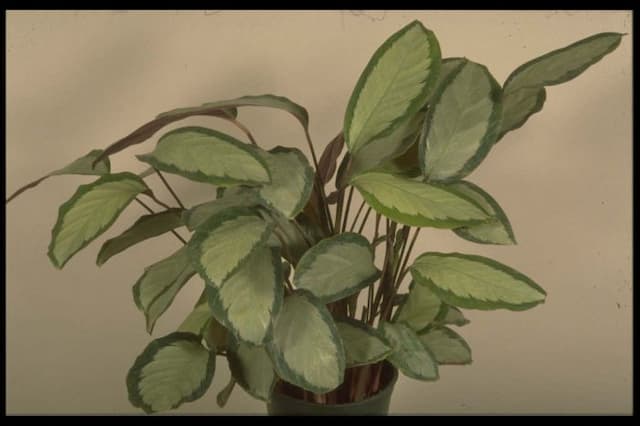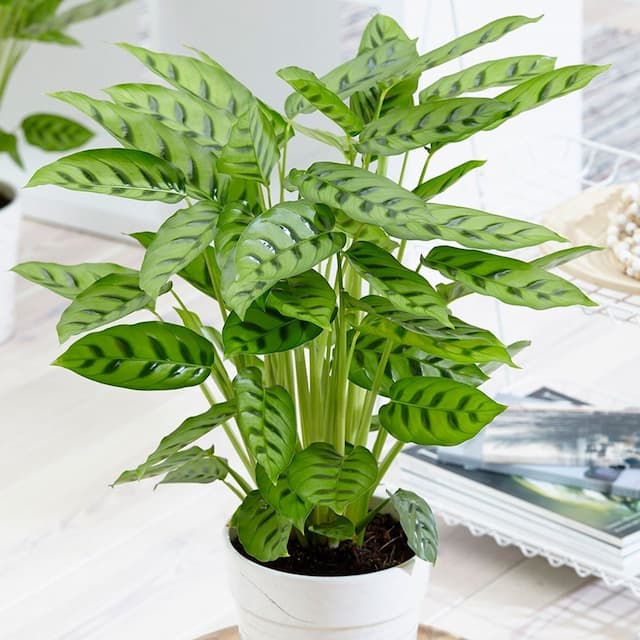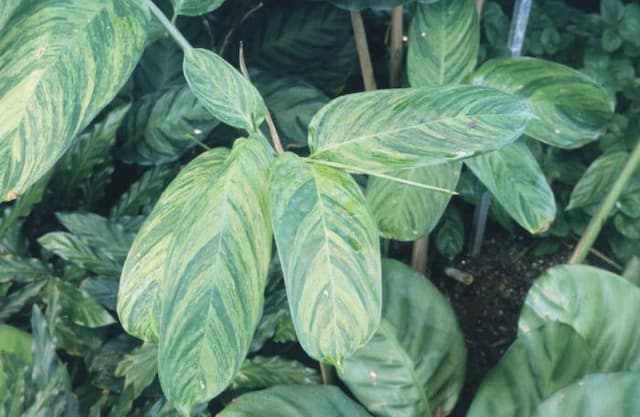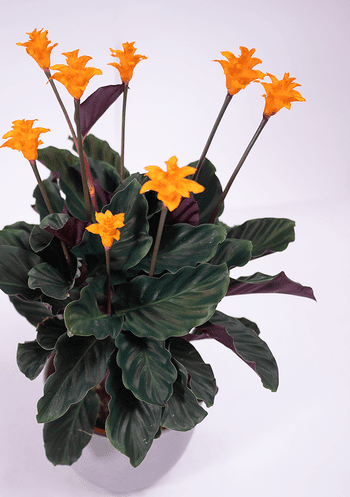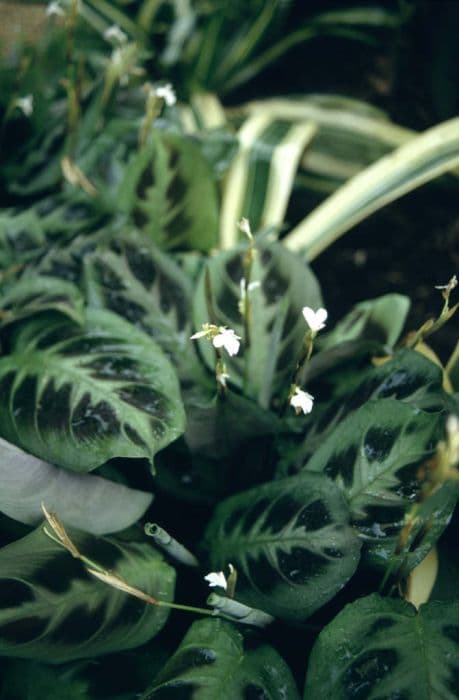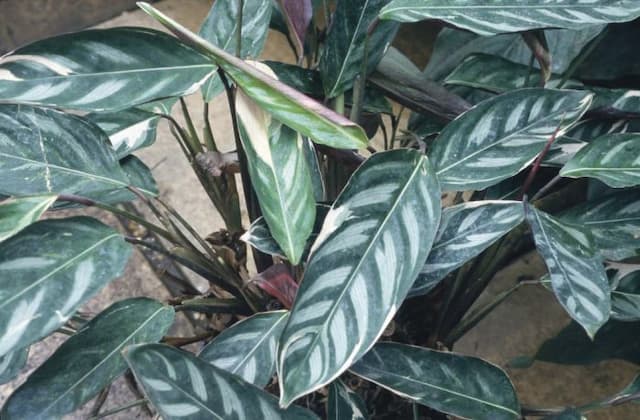Peacock plant Goeppertia makoyana

ABOUT
G. makoyana is a clump-forming evergreen perennial, with long-stalked ovate silvery-green leaves, with darker veins and regular dark blotches each side of the midrib, and purple beneath; small purple and white flowers in spikes
About this plant
 Names
NamesFamily
Marantaceae
Synonyms
Peacock Plant, Cathedral Windows, Brain Plant
Common names
Calathea makoyana, Maranta makoyana, Phrynium makoyana.
 Characteristics
CharacteristicsLife cycle
Perennials
Foliage type
Evergreen
Color of leaves
Variegated
Height
2 feet (60 cm)
Spread
2 feet (60 cm)
Plant type
Herb
Hardiness zones
11
Native area
Brazil
Benefits
 General Benefits
General Benefits- Aesthetic Appeal: Goeppertia makoyana, commonly known as the Peacock Plant, has strikingly patterned leaves which add visual interest to indoor spaces.
- Humidity Tolerance: The Peacock Plant thrives in humid environments, making it well-suited for bathrooms and kitchens.
- Low Light Adaptation: It can adapt to lower light conditions, although its patterns may not be as vibrant as when grown in bright, indirect light.
- Compact Growth: With its compact growth habit, the Peacock Plant is ideal for small spaces and tabletops.
- Easy Propagation: It is relatively easy to propagate through division, allowing gardeners to create new plants from an existing one.
 Medical Properties
Medical PropertiesThis plant is not used for medical purposes.
 Air-purifying Qualities
Air-purifying QualitiesThis plant is not specifically known for air purifying qualities.
 Other Uses
Other UsesThe Peacock Plant can be used in terrariums due to its humidity requirements and tropical appearance, enhancing the aesthetic of a miniature rainforest environment.
Because of its compact size, the Peacock Plant is ideal for decorating office desks or small shelves, where larger plants might not fit.
The patterned leaves of the Peacock Plant are sometimes used in art classes or botanical illustration workshops to teach students about leaf textures and patterns.
In photography, the Peacock Plant can serve as a natural prop or backdrop for product shots, due to its visually striking foliage.
This plant can be used as a learning tool for children to teach responsibility through caring for a living organism.
The Peacock Plant's non-toxic leaves make it a safe choice for households with pets, where it can be placed without worrying about the health of animals.
During themed events or parties, the Peacock Plant can be incorporated into decorations to add a touch of tropical elegance.
The leaves of the Peacock Plant can be used as natural bookmarks that add a botanical touch to the reading experience.
Practicing feng shui enthusiasts may use the Peacock Plant to balance and enhance the flow of energy in a home or office space.
In crafting, the silhouette or the impression of the Peacock Plant's leaves can be used to create nature-inspired designs on fabrics or papers.
Interesting Facts
 Feng Shui
Feng ShuiThe Calathea is not used in Feng Shui practice.
 Zodiac Sign Compitability
Zodiac Sign CompitabilityThe Calathea is not used in astrology practice.
 Plant Symbolism
Plant Symbolism- Tropical Elegance: Goeppertia makoyana, commonly known as the Calathea makoyana, often symbolizes the beauty and elegance found in tropical environments, reflecting its origin from the rainforests of Brazil.
- Privacy and Secret Keeping: Due to its patterned leaves that resemble peacock feathers, it is considered to symbolize privacy and keeping secrets, as the patterns may symbolize hidden messages or concealed beauty.
- Spiritual Connection: Some cultures may associate the Calathea makoyana with a spiritual connection to nature because of its characteristic of folding up its leaves during the night, which is interpreted as prayerful or meditative behavior.
- Balanced Energy: The pattern and symmetry of the leaves can represent balance and harmony, making this plant a symbol of bringing balanced energy into one's space.
 Water
WaterThe Peacock Plant (Goeppertia makoyana) should be watered when the top inch of soil begins to feel dry to the touch. Generally, this will be roughly once a week, but you should always check the soil moisture first as overwatering can cause root rot. Provide the plant with approximately 8-10 ounces of water, ensuring it's distributed evenly across the soil. During the winter months, reduce watering slightly as the plant's growth slows down. It's important not to let the plant sit in water, so ensure any excess is able to drain away.
 Light
LightThe Peacock Plant thrives in bright, indirect sunlight. It should be placed in a spot where the light is filtered, such as behind a sheer curtain or in a room with a south- or east-facing window. Direct sun can scorch its leaves, so avoid placing it in direct sunlight. The ideal lighting conditions will simulate the dappled light of its natural rainforest habitat.
 Temperature
TemperatureThe Peacock Plant prefers warm conditions and will thrive in a temperature range between 65 and 80 degrees Fahrenheit. It should not be exposed to temperatures below 60 degrees Fahrenheit as cold can damage the plant. The ideal temperature for this plant is around 70 degrees Fahrenheit which encourages healthy growth and vibrant foliage.
 Pruning
PruningPruning the Peacock Plant is mostly for aesthetic reasons and to remove any yellowed or dead leaves to maintain a neat appearance. It's best to prune in the spring or early summer when the plant is entering its active growth phase. Using clean, sharp scissors, cut the leaves at the base near the soil line. Regular pruning every few months can also encourage bushier growth.
 Cleaning
CleaningAs needed
 Soil
SoilThe Calathea makoyana, commonly known as the peacock plant, thrives best in a well-draining soil mix consisting of two parts peat or coco coir with one part perlite or pumice to promote aeration. A pH range of 6.0 to 6.5 is suitable for this plant.
 Repotting
RepottingPeacock plants should be repotted every one to two years, or when roots become pot-bound. Repotting is best done during the spring season when the plant is in its active growth phase.
 Humidity & Misting
Humidity & MistingPeacock plants require high humidity levels, ideally between 60% to 70%, to mimic their native tropical environment. Using a humidifier or placing a water tray nearby can help maintain these conditions.
 Suitable locations
Suitable locationsIndoor
Place peacock plant in bright, indirect light and maintain high humidity.
Outdoor
Grow in shade, protect from wind, and ensure high humidity for peacock plant.
Hardiness zone
11-12 USDA
 Life cycle
Life cycleGoeppertia makoyana, commonly known as the Peacock plant, begins its life cycle as a seed, which under suitable warmth and moisture conditions, germinates into a small seedling. This seedling will then develop into a juvenile plant with characteristic, decorative leaves, yet at a smaller scale compared to mature plants. As it grows, the Peacock plant enters a phase of vegetative growth, where it focuses on leaf development and root expansion, gradually forming its striking leaf patterns and vibrant colors. Reaching maturity, the plant may produce inflorescences, though flowering is relatively rare when cultivated indoors. If flowering does occur, and pollination is successful, it can produce seeds, thus completing its reproductive cycle. Throughout its life, the Peacock plant will go through periodic leaf shedding and regrowth, maintaining its lush appearance.
 Propogation
PropogationPropogation time
Spring-Early Summer
The Goeppertia makoyana, commonly known as the Calathea makoyana or Peacock Plant, can be propagated during the warmer growing season, typically in the spring and early summer. The most popular method of propagation for this plant is by division. To propagate by division, remove the plant from its pot and gently separate the rhizomes, ensuring that each division has at least one or two shoots and a healthy root system. After separating, pot each division into a container with fresh potting mix, making sure not to bury the stems too deeply. Water the new plants thoroughly and place them in a warm, well-lit area, avoiding direct sunlight, which can scorch their delicate leaves. Maintain a high humidity level and keep the soil consistently moist without letting it become waterlogged to encourage root development and minimize stress on the young plants.


